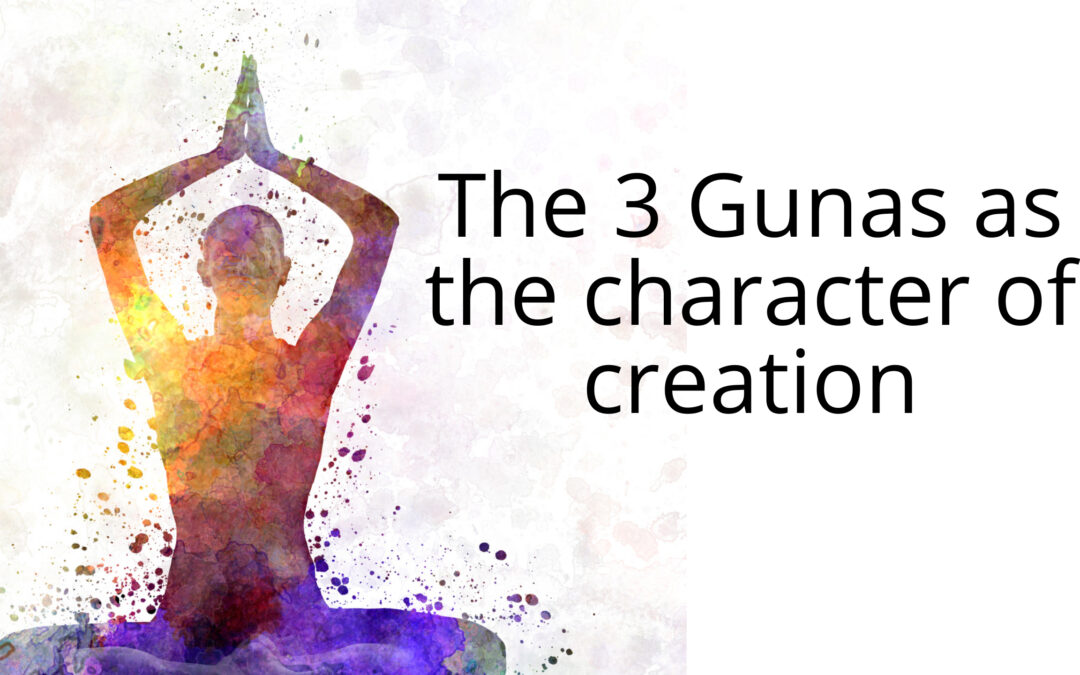There are three natural forces that move, sustain, and bind the entire creation. These forces, known as the three gunas in Ayurveda, are qualities that the five elements take on in the process of manifesting and binding matter. The gunas—Tamas, Rajas, and Sattva—are constantly at work in all organic and inorganic matter, giving character, flavor, and foundation to our earth bodies, which comprise the physical, etheric, emotional, and mental layers.
Your earth bodies are continuously influenced by these three qualities. In fact, when you remain under their influence for extended periods, you may even begin to believe that you are these qualities themselves. As long as we inhabit our bodies—even as we incarnate into new ones—we must contend with these three natural forces.
Ayurveda provides the most coherent description and understanding of these forces, referring to them as “Gunas,” a Sanskrit term meaning “that which binds.” If misunderstood, the gunas bind us to the external world and the endless dance of the elements. Yet, it is also through the gunas that all matter is held together in infinite combinations. Thanks to them, we experience the mystical interplay of the elements within our bodies and minds, moving through cycles of decay, rest, and clarity.
The gunas are in constant flux, interacting to maintain balance, regeneration, and evolution.
The Three Gunas
1. Tamas: Substance and density; creates inertia.
2. Rajas: Energy and activity; creates imbalance.
3. Sattva: Essence and intelligence; imparts balance.
These qualities are present not only in our food but also in our environment, actions, words, minds, and even the company we keep.
—
Tamas
Tamas is the quality of inertia and rest. While necessary for regeneration and relaxation, excess tamas can lead to indulgence, attachment, and stagnation. In the plant kingdom, valerian is an example: though calming and helpful for sleep, overuse can cause dullness in body and mind.
Tamas is evident during sleep, when the body becomes denser and inactive. Excessive sleep increases tamas, leading to lethargy. In your earth bodies, tamas manifests as gluttony, indulgence, sloth, addiction, negativity, attachment, and identification with limitations. It promotes ignorance and delusion, insensitivity, material attachment, and loss of awareness. In a tamasic state, the world appears confusing and unsafe, leading to defensiveness and irresponsibility.
Tamas is heavy and obstructive, like gravity, slowing the movement of the elements and maintaining them in limited forms.
Tamasic Foods
Tamasic foods lower energy and vitality, hindering clear thinking and mental acuity. They include:
* Aged cheese, pickles, meat, fish, curds, leeks, margarine, ice cream, texturized vegetable protein, mushrooms, alcohol, and all fermented foods (vinegar, bread, pastries, cakes)
* Stale, overripe, underripe, tasteless, or rotten foods
* Tobacco, drugs, processed, preserved, canned, or frozen foods
* Fast food, fried food, microwave meals, leftovers
To support evolution and expanded self-perception, tamasic foods are best avoided.
—
Rajas
Rajas is the force of activity and change, driving us to act, seek, and strive for achievement. While rajas enables us to experience life’s dynamism, prolonged self-seeking action leads to fragmentation and inner turmoil. Short-term, rajas can be pleasurable and stimulating, but their imbalance quickly turns to pain and suffering.
Rajasic people are energetic and inspiring, but risk burnout by overextending themselves. Rajasic minds are characterized by being opinionated, power-seeking, impatient, and inconsistent. They may shirk responsibility, blame others, and remain unsatisfied despite their achievements.
Rajasic Foods
Rajasic foods overstimulate the senses and foster restlessness and aggression. They tend to be hot, bitter, sour, dry, or salty in taste. Eating too quickly also increases rajas. Examples include:
* Coffee, garlic, onion, chocolate, caffeinated teas, soft drinks
* Avocado, beans (garbanzo, kidney), brewer’s yeast, buttermilk (not fresh), hard cheese, chili, dried dates, eggs, eggplant, guava, kefir (not fresh), lemon, red lentils, lime, malt syrup, unripe mango, molasses, olives, peanut oil, peanuts, peppers, pickles, dried peas, salted pistachios, rhubarb, rice bran syrup, salt, sour cream, all types of sugar, sugar cane juice, tomatoes, vinegar, yogurt (not fresh)
These foods can promote activity and restlessness, but they need not be completely avoided; rather, it is helpful to be mindful of their effects.
—
Sattva
A predominance of sattva is crucial for maintaining physical health, fostering creativity, and promoting spiritual growth. Sattva is the flow of natural intelligence and balance, facilitating pure perception, purpose, and self-realization. It brings cleanliness, adaptability, creativity, and harmony between tamas and rajas. The sattvic mind is peaceful, fostering true wellness and healing.
With sattva, you take responsibility for your experiences and embody kindness, compassion, clarity, and service. Life becomes a learning ground, and dualities like right and wrong fade, replaced by the curiosity to discover the mysteries of self.
Sattva is the balance between the energy of rajas and the stability of tamas. While cultivating sattva is central to self-evolution, it’s important not to become attached to virtue or purity, or to favor or avoid one quality over another. True progress is about evolution, patience, and awareness without clinging.
Sattvic Foods
Sattvic foods retain their nutritional value, ideally grown and prepared with care. The best options are fresh, organic, and homegrown. Examples include:
* Fresh fruits and vegetables (apples, bananas, berries, greens, carrots, broccoli, etc.)
* Whole grains (basmati rice, millet, oats, buckwheat, quinoa)
* Legumes (mung dahl, azuki, black beans, lentils)
* Fresh dairy (milk, butter, ghee, cream, fresh cheese, fresh buttermilk, yogurt)
* Nuts and seeds (almonds, walnuts, sesame, sunflower, etc.)
* Natural sweeteners (raw honey, maple syrup)
Sattva is a step toward transcending the limitations of the elements. This process requires patience, acceptance, and awareness to fully experience the present moment.
Transcending sattva leads to a space of stillness, potential, and pure presence—where only what is necessary arises, and the elements are no longer manipulated.
By managing the gunas, we create a foundation for the subtle vibrations of the divine to reside within us, making our bodies a clean and welcoming home.

